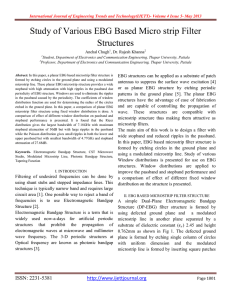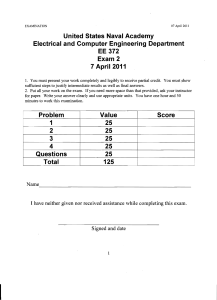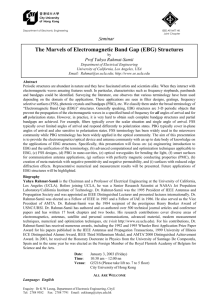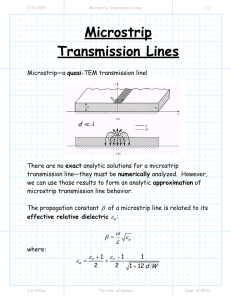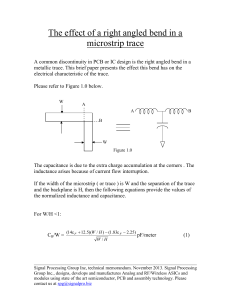Compact U-Shaped Dual Planar EBG Microstrip Low
advertisement
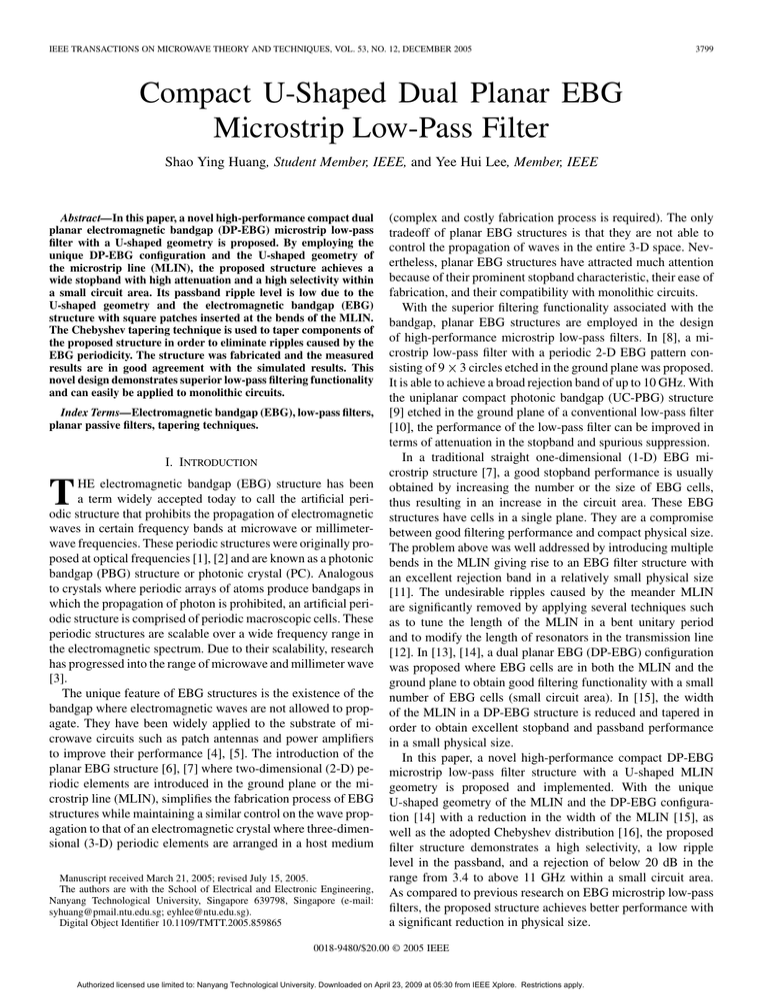
IEEE TRANSACTIONS ON MICROWAVE THEORY AND TECHNIQUES, VOL. 53, NO. 12, DECEMBER 2005 3799 Compact U-Shaped Dual Planar EBG Microstrip Low-Pass Filter Shao Ying Huang, Student Member, IEEE, and Yee Hui Lee, Member, IEEE Abstract—In this paper, a novel high-performance compact dual planar electromagnetic bandgap (DP-EBG) microstrip low-pass filter with a U-shaped geometry is proposed. By employing the unique DP-EBG configuration and the U-shaped geometry of the microstrip line (MLIN), the proposed structure achieves a wide stopband with high attenuation and a high selectivity within a small circuit area. Its passband ripple level is low due to the U-shaped geometry and the electromagnetic bandgap (EBG) structure with square patches inserted at the bends of the MLIN. The Chebyshev tapering technique is used to taper components of the proposed structure in order to eliminate ripples caused by the EBG periodicity. The structure was fabricated and the measured results are in good agreement with the simulated results. This novel design demonstrates superior low-pass filtering functionality and can easily be applied to monolithic circuits. Index Terms—Electromagnetic bandgap (EBG), low-pass filters, planar passive filters, tapering techniques. I. INTRODUCTION T HE electromagnetic bandgap (EBG) structure has been a term widely accepted today to call the artificial periodic structure that prohibits the propagation of electromagnetic waves in certain frequency bands at microwave or millimeterwave frequencies. These periodic structures were originally proposed at optical frequencies [1], [2] and are known as a photonic bandgap (PBG) structure or photonic crystal (PC). Analogous to crystals where periodic arrays of atoms produce bandgaps in which the propagation of photon is prohibited, an artificial periodic structure is comprised of periodic macroscopic cells. These periodic structures are scalable over a wide frequency range in the electromagnetic spectrum. Due to their scalability, research has progressed into the range of microwave and millimeter wave [3]. The unique feature of EBG structures is the existence of the bandgap where electromagnetic waves are not allowed to propagate. They have been widely applied to the substrate of microwave circuits such as patch antennas and power amplifiers to improve their performance [4], [5]. The introduction of the planar EBG structure [6], [7] where two-dimensional (2-D) periodic elements are introduced in the ground plane or the microstrip line (MLIN), simplifies the fabrication process of EBG structures while maintaining a similar control on the wave propagation to that of an electromagnetic crystal where three-dimensional (3-D) periodic elements are arranged in a host medium Manuscript received March 21, 2005; revised July 15, 2005. The authors are with the School of Electrical and Electronic Engineering, Nanyang Technological University, Singapore 639798, Singapore (e-mail: syhuang@pmail.ntu.edu.sg; eyhlee@ntu.edu.sg). Digital Object Identifier 10.1109/TMTT.2005.859865 (complex and costly fabrication process is required). The only tradeoff of planar EBG structures is that they are not able to control the propagation of waves in the entire 3-D space. Nevertheless, planar EBG structures have attracted much attention because of their prominent stopband characteristic, their ease of fabrication, and their compatibility with monolithic circuits. With the superior filtering functionality associated with the bandgap, planar EBG structures are employed in the design of high-performance microstrip low-pass filters. In [8], a microstrip low-pass filter with a periodic 2-D EBG pattern consisting of 9 3 circles etched in the ground plane was proposed. It is able to achieve a broad rejection band of up to 10 GHz. With the uniplanar compact photonic bandgap (UC-PBG) structure [9] etched in the ground plane of a conventional low-pass filter [10], the performance of the low-pass filter can be improved in terms of attenuation in the stopband and spurious suppression. In a traditional straight one-dimensional (1-D) EBG microstrip structure [7], a good stopband performance is usually obtained by increasing the number or the size of EBG cells, thus resulting in an increase in the circuit area. These EBG structures have cells in a single plane. They are a compromise between good filtering performance and compact physical size. The problem above was well addressed by introducing multiple bends in the MLIN giving rise to an EBG filter structure with an excellent rejection band in a relatively small physical size [11]. The undesirable ripples caused by the meander MLIN are significantly removed by applying several techniques such as to tune the length of the MLIN in a bent unitary period and to modify the length of resonators in the transmission line [12]. In [13], [14], a dual planar EBG (DP-EBG) configuration was proposed where EBG cells are in both the MLIN and the ground plane to obtain good filtering functionality with a small number of EBG cells (small circuit area). In [15], the width of the MLIN in a DP-EBG structure is reduced and tapered in order to obtain excellent stopband and passband performance in a small physical size. In this paper, a novel high-performance compact DP-EBG microstrip low-pass filter structure with a U-shaped MLIN geometry is proposed and implemented. With the unique U-shaped geometry of the MLIN and the DP-EBG configuration [14] with a reduction in the width of the MLIN [15], as well as the adopted Chebyshev distribution [16], the proposed filter structure demonstrates a high selectivity, a low ripple level in the passband, and a rejection of below 20 dB in the range from 3.4 to above 11 GHz within a small circuit area. As compared to previous research on EBG microstrip low-pass filters, the proposed structure achieves better performance with a significant reduction in physical size. 0018-9480/$20.00 © 2005 IEEE Authorized licensed use limited to: Nanyang Technological University. Downloaded on April 23, 2009 at 05:30 from IEEE Xplore. Restrictions apply. 3800 IEEE TRANSACTIONS ON MICROWAVE THEORY AND TECHNIQUES, VOL. 53, NO. 12, DECEMBER 2005 Fig. 1. Schematic of: (a) a straight EBG microstrip structure, (b) a U-shaped MLIN, and (c) a U-shaped EBG microstrip structure. In Section II, the U-shaped MLIN geometry is studied and the performance of the U-shaped EBG microstrip structure with square patches inserted in the MLIN is analyzed. The design of the compact U-shaped DP-EBG microstrip low-pass filter structure is proposed in Section III. The proposed structure was fabricated and tested. The measured results are presented and analyzed in Section IV. II. STUDY OF U-SHAPED GEOMETRY not a conventional stepped-impedance microstrip low-pass filter [17] since it is designed to satisfy the Bragg reflection condition. equals half of the peThe edge of the inserted square patch riod , which is equivalent to an optimal filling factor of 0.25 [6]. Compared to the straight EBG microstrip structure, the U-shaped EBG microstrip structure in Fig. 1(c) is more compact in physical size and may provide additional flexibility in circuit layout designs. The performance of the structure in Fig. 1(c) is affected by the resonator created in the MLIN that is presented in its corresponding U-shaped MLIN [see Fig. 1(b)] because the resonator causes resonance in the transmission of the U-shaped EBG structure. The resonator in an MLIN with is the result of the multiple bends the number of bends reflections between two consecutive or nearby bends (with one bend in between). The resonant frequency is determined by the physical length of the resonator. Base on a study on the meander MLIN [12], the relation between the length of the resonator and the resonant frequency can be expressed using (3) as follows: (3) where is the physical length of the resonator, is an integer, is the guided wavelength corresponding to the resonant and is expressed as the following: frequency . (4) Hence, A. U-Shaped EBG Microstrip Structure (5) Fig. 1(a) shows the schematic of a straight EBG microstrip structure with four square patches inserted in the MLIN at a period of and Fig. 1(b) shows that of a U-shaped MLIN where the distance between the two parallel sections is also . Fig. 1(c) shows the schematic of the U-shaped EBG microstrip structure used in the proposed compact U-shaped DP-EBG microstrip low-pass filter structure. It is a combination of the structures in Fig. 1(a) and (b) with the 90 bending taking place at the center point of the second and the third patch from the leftto right-hand side. The EBG structures in Fig. 1(a) and (c) are single planar (SP) structures since their EBG cells are arranged only in the MLIN. The straight EBG microstrip structure in Fig. 1(a) satisfies the Bragg reflection condition [7], which is expressed by the following equation: (1) where is the wavenumber in the substrate material and is where is the the period of the structure. Since guided wavelength corresponding to the center frequency of the is decided by stopband , (2) where is the speed of light in free space and is the effective dielectric constant. The straight EBG microstrip structure is As can be seen in Fig. 1(b), the U-shaped MLIN contains two bends. Therefore, it has only one resonator with a length of , as shown by the shadowed area. According to (5), with set to 1, its resonant frequency is the same as the center frequency of the stopband in the straight EBG structure [see Fig. 1(a)] as approximated by (2). As compared to the meander line in [12], the U-shaped MLIN has less bends. As a result, U-shaped structures may have smaller power loss caused by the radiation and scattering that take place at the bend. In the U-shaped MLIN, there is only one resonator and its length is as short as one EBG period. Due to the absence of a resonator with a length longer than , no resonance is introduced at frequencies lower than . B. Numerical Results and Analysis The transmission characteristics of an EBG microstrip structure with multiple bends are determined by the responses of the two individual structures; the corresponding straight EBG structure and the MLIN with a corresponding geometry. In order to study the proposed U-shaped EBG microstrip structure, the three structures in Fig. 1 are simulated using the method-of-moment (MoM)-based software Zeland IE3D. Taconic, with a diof 2.43 and a thickness of 0.76 mm, electric constant is used as the substrate. The center frequency of the stopband is set to 7.5 GHz, resulting in a period of the structure of 13.78 mm. The edge of the square patch is set to 6.89 mm, Authorized licensed use limited to: Nanyang Technological University. Downloaded on April 23, 2009 at 05:30 from IEEE Xplore. Restrictions apply. HUANG AND LEE: COMPACT U-SHAPED DP-EBG MICROSTRIP LOW-PASS FILTER 3801 Fig. 3. Simulated phase delay in the output wave with respect to the input wave in a bent unitary period and in a straight unitary period. Fig. 2. Simulated S -parameters of structures in Fig. 1. (a) S . (b) S . which equals half of the period. The width of the MLIN is 2.32 mm corresponding to a characteristic impedance of 50 at - and -pa7.5 GHz. Fig. 2(a) and (b) shows the simulated rameter, respectively. As can be seen in Fig. 2(a), the U-shaped MLIN shows slight attenuation in the higher frequency range of 6 GHz and above. The small resonance in the transmission is due to the resonator where reflections take place between the bends. With a physical length of 13.78 mm, the resonator causes slight resonance centered at approximately 7.5 GHz, which is the same as that predicted using (5). The straight EBG microstrip structure shows a prominent stopband centered at approximately 7 GHz, which indicates that it satisfies the Bragg reflection condition. The U-shaped EBG microstrip structure (a combination of the two above-mentioned structures) obtains a wider stopband with higher attenuation and an increase in selectivity, yet without compromising the ripple level in the lower passband. The low passband ripple level of the U-shaped EBG structure is -parameter in indicated by the low sidelobe level of its Fig. 2(b). The results reveal that the U-shaped MLIN geometry is able to enhance the filtering functionality of the EBG structure with square patches inserted in the MLIN. The enhancement is ob- tained without producing any additional ripple. This is mainly because in the proposed EBG structure with a U-shaped MLIN geometry, the absence of the resonator with a length that is avoids resonance at longer than one period of the structure frequencies lower than the center frequency of the stopband. In an EBG microstrip structure with bends, the difference between the phase delay of a bent unitary period and that of a straight one causes an increase in the passband ripple level. As was reported in [12], for the meander EBG microstrip structure with circles etched in the ground plane below a bend, the bending of a unitary period introduces a reduction in the phase delay, thus increasing the passband ripple level. A study on the bent section of the proposed U-shaped EBG structure in Fig. 1(c) is performed. Fig. 3 shows the phase delay of the bent unitary period (shadowed area) and that of the straight unitary period (meshed area). As indicated in Fig. 3, in the U-shaped EBG structure with a square patch inserted in the MLIN at a bend [see Fig. 1(c)], the phase delay of the bent unitary period is the same as that of the straight unitary period over a wide frequency range from dc to 6.76 GHz. Since the bending of the unitary period does not introduce any difference in phase delay, the proposed U-shaped EBG microstrip structure is able to maintain a low passband ripple level with enhanced stopband performance. Additional power loss caused by the radiation and scattering that take place at the bend is another important issue in an EBG microstrip structure with bends. In the meander EBG microstrip structure in [11] and [12], the radiation and scattering at the bend with an etched circle below introduce a significant amount of additional power loss, thus degrading the performance of the filter structure. The radiation and scattering in a meander microstrip structure can be estimated in terms of percentage using Radiation + Scattering, (6) The power loss of the U-shaped EBG microstrip structure in Fig. 1(c) is studied. Fig. 4 shows the simulated radiation and scattering level of the U-shaped EBG structure [see Fig. 1(c)] and that of the straight EBG structure [see Fig. 1(a)] for comparison. As can be seen in Fig. 4, the power loss of the U-shaped Authorized licensed use limited to: Nanyang Technological University. Downloaded on April 23, 2009 at 05:30 from IEEE Xplore. Restrictions apply. 3802 IEEE TRANSACTIONS ON MICROWAVE THEORY AND TECHNIQUES, VOL. 53, NO. 12, DECEMBER 2005 Fig. 4. Simulated radiation and scattering levels for the U-shaped EBG microstrip structure and the straight EBG structure. EBG structure is similar to that shown by the straight one over a frequency range dc–9.42 GHz. This is mainly attributed to the small number of bends in the U-shaped structure. The similar radiation and scattering level is also due to the square patch inserted at the bend of the MLIN that eliminates additional power loss introduced at the bend. In single planar EBG (SP-EBG) structures, the proposed U-shaped EBG microstrip structure with patches periodically inserted in the MLIN is a compact structure with good filtering functionality. Fig. 5. Schematic of the proposed high-performance compact U-shaped DP-EBG microstrip low-pass filter structure. (a) 3-D view. (b) Top view 1. (c) Top view 2. TABLE I NORMALIZED COEFFICIENTS OF CHEBYSHEV ARRAYS III. COMPACT U-SHAPED DP-EBG MICROSTRIP LOW-PASS FILTER A. Design By applying the U-shaped MLIN geometry analyzed above, a compact U-shaped DP-EBG microstrip structure is proposed. Fig. 5(a) shows the 3-D schematic of the proposed structure. A U-shaped EBG microstrip structure with square patches periodically inserted in the MLIN is on top of a perturbed ground plane with etched circles creating a dual planar configuration [14]. As indicated in Fig. 5(a), the substrate material has a dielectric constant of and a thickness of . Fig. 5(b) shows the relative location of the patches and the circles and Fig. 5(c) shows their dimensions. The width of the MLIN is set corresponding to a characteristics impedance of 50 and the square patches are inserted at a period of according to the Bragg reflection condition for a center frequency of . Circles are etched exactly below the MLIN with their centers allocated at the center point of two , which constructs anconsecutive square patches other SP-EBG structure [14] with a period of . The etched circles are for enhancing the contrast of the equivalent reactance in the EBG cell, thus improving the stopband performance of the structure. For the same purpose, as was reported in [15], the width of the MLIN above the etched circle is reduced so as to further increase the bandwidth and attenuation of the stopband, (where ). resulting in To eliminate ripples caused by the periodicity of the design, the Chebyshev distribution [16] is adopted to taper the area of the etched circle and the inserted square patch. It results in the and and the corresponding length corresponding radius and . An optimal filling factor of 0.25 of the edge [6] is used to determine the radius of the central circle . The is set to avoid any edge length of the two central squares overlap between the circle in the ground plane and the square patch in the MLIN in order to obtain a sharp reactance contrast in an EBG cell for ensuring good filtering performance of the structure. The effect of the reduction in the width of has been studied and it was found that the MLIN is also tagood performance can be obtained when pered [15]. A three- and a four-element Chebyshev array with a major-to-minor ratio of 25 dB are used for the proposed design and the normalized coefficients are tabulated and shown in Table I. B. Numerical Results The proposed U-shaped DP-EBG microstrip structure is sim, mm) is used as the ulated. Taconic ( is set to substrate and the center frequency of the stopband 7.5 GHz. Table II shows the numerical values of the parameters set. Fig. 6 shows a comparison between the simulated -parameters of the proposed U-shaped DP-EBG structure and those of the U-shaped SP-EBG microstrip structure [see Fig. 1(c)]. Authorized licensed use limited to: Nanyang Technological University. Downloaded on April 23, 2009 at 05:30 from IEEE Xplore. Restrictions apply. HUANG AND LEE: COMPACT U-SHAPED DP-EBG MICROSTRIP LOW-PASS FILTER TABLE II PARAMETERS OF THE PROPOSED LOW-PASS FILTER 3803 TABLE III SIMULATED PERFORMANCE AND CIRCUIT AREA EBG MICROSTRIP STRUCTURES OF U-SHAPED Fig. 7. Fabricated compact U-shaped DP-EBG microstrip low-pass filter structure: MLIN (left), ground plane (right). U-shaped DP-EBG structure exhibits a much lower sidelobe level than that of the U-shaped SP-EBG structure, which clearly indicates the smooth transmission in the passband of the novel dual planar design. The improvement of the stopband performance and the increase in selectivity of the proposed DP-EBG microstrip structure can mainly be attributed to the dual planar configuration where circles are etched in the ground plane. It can also be attributed to the reduction in the width of the MLIN above the etched circle, which increases the variation of equivalent reactance in an EBG cell. The significant elimination of the passband ripple in this dual planar structure is due to the tapering of all three components of the structure: the etched circles in the ground plane, the inserted square patches in the MLIN, and the (reduction in) width of the MLIN. Within a small circuit area, this proposed U-shaped DP-EBG microstrip structure shows excellent low-pass filtering functionality with superior passband and stopband characteristics. As compared to previous work [8], [10], the proposed design achieves significant improvement in the selectivity and a great reduction in both the physical size and passband insertion loss. Fig. 6. Simulated S -parameters for the proposed U-shaped DP-EBG microstrip low-pass filter structure and the U-shaped SP-EBG microstrip structure. (a) S . (b) S . As can be seen from Fig. 6(a), the U-shaped DP-EBG structure shows a selectivity of approximately 22.50 dB/GHz, a passband ripple level of 0.20 dB, and an excellent stopband performance. There is a good stopband attenuation of more than 20 dB for frequencies of 3.4 GHz and above. Table III shows the performance and circuit area of the U-shaped DP-EBG structure and those of the U-shaped SP-EBG structure. As can be seen in Table III, within the same circuit area as that of the U-shaped SP-EBG structure as shown in Fig. 1(c), the proposed U-shaped DP-EBG structure achieves a significant increase in the bandwidth and attenuation of the stopband, a higher selectivity, and a -pamuch smaller passband ripple level. Fig. 6(b) shows the rameters of the two structures. As can be seen in Fig. 6(b), the IV. MEASUREMENT RESULTS AND ANALYSIS The proposed compact U-shaped DP-EBG microstrip low-pass filter structure was fabricated and tested. Fig. 7 shows the MLIN and ground plane of the fabricated structure and Fig. 8 shows its measured and simulated -parameters. As shown in Fig. 7, the physical size of the proposed structure is small. EBG cells are allocated in both the MLIN (the inserted square patches) and ground plane (the etched circles). The input and output port are on the same side of the circuit, which may offer a greater degree of flexibility in the layout of microwave circuits designs. As can be seen in Fig. 8, the measured results show good agreement with the simulated results. The stopband of the measured result is not as smooth as that of the simulated result due to the additional connectors used for the testing of the structure and the nonideal fabrication and material. However, as shown Authorized licensed use limited to: Nanyang Technological University. Downloaded on April 23, 2009 at 05:30 from IEEE Xplore. Restrictions apply. 3804 IEEE TRANSACTIONS ON MICROWAVE THEORY AND TECHNIQUES, VOL. 53, NO. 12, DECEMBER 2005 in a compact physical size. The passband ripple level of the novel U-shaped DP-EBG structure is very low, which can be attributed to the unique MLIN geometry, as well as the tapering technique (Chebyshev distribution) by means of which the passband ripples caused by the periodicity in the structure are effectively eliminated. The proposed filter structure is easy to fabricate and shows compatibility with monolithic-microwave integrated-circuit (MMIC) technology. The novel design of this structure is able to achieve superior passband and stopband characteristics in a small circuit area. The structure was fabricated and tested for its performance. The good performance of the proposed structure is verified from the measured results, as they are in good agreement with the simulated results. REFERENCES Fig. 8. Simulated and measured S -parameters of the proposed U-shaped DP-EBG microstrip low-pass filter structure. (a) S . (b) S . in Fig. 8(a), the fabricated structure still demonstrates a wide stopband with an attenuation of over 20 dB at the frequencies above 3.4 GHz. The passband ripple level shown in the measured result is as low as 0.33 dB, which is indicated by the low -parameter in Fig. 8(b). A sidelobe level of the measured good selectivity of 22.50 dB/GHz can also be observed for the measured result. The proposed structure is compact in size and is able to achieve excellent passband and stopband performance. This filter structure can easily be applied to circuit applications requiring low-pass filtering functionality. The unique U-shaped MLIN geometry provides additional flexibility for the allocation of components in circuit designs, thus potentially improving the compactness of circuits. V. CONCLUSION In this paper, the design and implementation of a novel high-performance compact U-shaped DP-EBG microstrip low-pass filter structure has been presented. Due to the U-shaped geometry of the MLIN and the dual planar arrangement of EBG structures, this proposed EBG filter structure obtains excellent stopband performance and a high selectivity [1] E. Yablonovitch, “Inhibited spontaneous emission in solid-state physics and electronics,” Phys. Rev. Lett., vol. 58, no. 20, pp. 2059–2062, May 1987. [2] S. John, “Strong localization of photons in certain disordered dielectric superlattices,” Phys. Rev. Lett., vol. 58, no. 23, pp. 2486–2489, Jun. 1987. [3] E. R. Brown, C. D. Parker, and E. Yablonovitch, “Radiation properties of a planar antenna on a photonic-crystal substrate,” J. Opt. Soc. Amer. B, Opt. Phys., vol. 10, no. 2, pp. 404–407, Feb. 1993. [4] R. Gonzalo, P. De Maagt, and M. Sorolla, “Enhanced patch-antenna performance by suppressing surface waves using photonic-bandgap substrates,” IEEE Trans. Microw. Theory Tech., vol. 47, no. 11, pp. 2131–2138, Nov. 1999. [5] V. Radisic, Y. Qian, and T. Itoh, “Broad-band power amplifier using dielectric photonic bandgap structure,” IEEE Microw. Guided Wave Lett., vol. 8, no. 1, pp. 13–14, Jan. 1998. [6] V. Radisic, Y. Qian, R. Coccioli, and T. Itoh, “Novel 2-D photonic bandgap structure for microstrip lines,” IEEE Microw. Guided Wave Lett., vol. 8, no. 2, pp. 69–71, Feb. 1998. [7] F. Falcone, T. Lopetegi, and M. Sorolla, “1-D and 2-D photonic bandgap microstrip structures,” Microwave Opt. Technol. Lett., vol. 22, no. 6, pp. 411–412, Sep. 1999. [8] M. Bozzetti, A. D’Orazio, M. De Sario, V. Petruzzelli, F. Prudenzano, and F. Renna, “Tapered photonic bandgap microstrip lowpass filters: Design and realization,” Proc. Inst. Elect. Eng.–Microwaves, Antennas, Propag., vol. 150, no. 6, pp. 459–462, Dec. 2003. [9] F. Yang, K. Ma, Y. Qian, and T. Itoh, “A uniplanar compact photonicbandgap (UC-PBG) structure and its applications for microwave circuit,” IEEE Trans. Microw. Theory Tech., vol. 47, no. 8, pp. 1509–1514, Aug. 1999. [10] F. Yang, Y. Qian, and T. Itoh, “A novel uniplanar compact PBG structure for filter and mixer applications,” in IEEE MTT-S Int. Microwave Symp. Dig., vol. 3, Jun. 1999, pp. 912–922. [11] F. Falcone, T. Lopetegi, M. Irisarri, M. A. G. Laso, M. J. Erro, and M. Sorolla, “Compact photonic bandgap microstrip structures,” Microwave Opt. Technol. Lett., vol. 23, no. 4, pp. 233–236, Nov. 1999. [12] T. Lopetegi, M. A. G. Laso, M. Irisarri, M. J. Erro, F. Falcone, and M. Sorolla, “Optimization of compact photonic bandgap microstrip structures,” Microwave Opt. Technol. Lett., vol. 26, no. 4, pp. 211–216, Aug. 2000. [13] T. Akalin, M. A. G. Laso, E. Delos, T. Lopetegi, O. Vanbesien, M. Sorolla, and D. Lippens, “High performance double-sided microstrip PBG filter,” Microwave Opt. Technol. Lett., vol. 35, no. 2, pp. 90–93, Oct. 2002. [14] S. Y. Huang and Y. H. Lee, “Tapered dual-plane compact electromagnetic bandgap microstrip filter structure,” IEEE Trans. Microw. Theory Tech., vol. 53, no. 9, pp. 2656–2664, Sep. 2005. [15] , “A tapered small-size EBG microstrip bandstop filter design with triple EBG structures,” Microwave Opt. Technol. Lett., vol. 46, no. 2, pp. 154–158, Jul. 2005. [16] N. C. Karmakar and M. N. Mollah, “Investigations into nonuniform photonic-bandgap microstripline low-pass filters,” IEEE Trans. Microw. Theory Tech., vol. 51, no. 2, pp. 564–572, Feb. 2003. [17] D. M. Pozar, Microwave Engineering, 2nd ed. New York: Wiley, 1998, pp. 470–473. Authorized licensed use limited to: Nanyang Technological University. Downloaded on April 23, 2009 at 05:30 from IEEE Xplore. Restrictions apply. HUANG AND LEE: COMPACT U-SHAPED DP-EBG MICROSTRIP LOW-PASS FILTER Shao Ying Huang (S’05) received the B.Eng. degree from Nanyang Technological University, Singapore, in 2002, and is currently working toward the M.Eng. degree in electrical and electronic engineering at Nanyang Technological University. Her research interest includes the design, development and modeling of EBG structures and their applications. 3805 Yee Hui Lee (M’95) received the B.Eng. and M.Eng. degrees from the Nanyang Technological University, Singapore, in 1996 and 1998, respectively, and the Ph.D. degree from the University of York, York, U.K., in 2002. Since July 2002, she has been an Assistant Professor with the School of Electrical and Electronic Engineering, Nanyang Technological University, Singapore. Her interest is in evolutionary techniques, computational electromagnetics, and antenna design. Authorized licensed use limited to: Nanyang Technological University. Downloaded on April 23, 2009 at 05:30 from IEEE Xplore. Restrictions apply.
